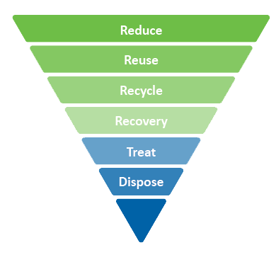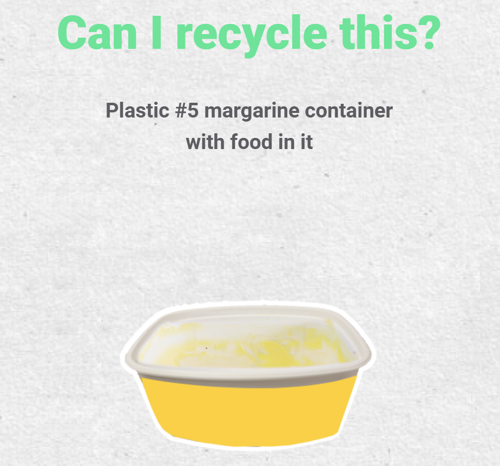Recycling and Reuse
In addition to recycling your used household items through Council's Kerbside Recycling Collection Service, there are many ways that you can reduce your household waste being sent to Landfill.
A great framework to help get started is the waste hierarchy (see diagram). This useful guide sets out how each of us should be dealing with waste responsibly.

Reduce
The easiest way to minimise waste is to avoid it in the first place. Reduce is at the top of the hierarchy, because if we do that first, there’ll be less waste left over to dispose of. Here are some easy, everyday examples of reducing:
- Buy loose fruit and vegetables instead of packaged items
- Take your own container to a takeaway shop instead of using their disposable container
These simple examples of waste reduction mean there is less (or nothing) to dispose of at the end.
Reuse
The next-best way to minimise waste is to reuse. Reusing is all about seeing waste differently – not as something disposable, but something useful for a second, third, and fourth time, or another purpose altogether.
By reusing again and again, we can use items for as long as possible before they ultimately end up in our landfills. Here are some ways to reuse items that you may already be familiar with:
- Take the same bags to the supermarket each time
- Carry a reusable water bottle whenever you’re out and about – most cafes are happy to refill for you, just ask.
- Use old scarves or material as ribbons or gift wrap.
Recycle
The third approach on the hierarchy is something we’re all familiar with – recycle. Recycling is when we convert waste into a new object or material. It’s another great way to keep things out of the landfill.
Recycling has been done for many years, because it uses less energy and raw materials than producing new items from scratch. It’s also typically cheaper to recycle than send items to landfill.
However, recycling can only be successful if everyone takes responsibility to recycle correctly, which can sometimes be confusing.
Recycling is third on the hierarchy because it is not completely waste-free; if recycling is contaminated, then the items still end up going into landfill, and some things can only be recycled a certain number of times:
- Plastics can typically be recycled only 7 to 9 times
- Paper and cardboard can typically be recycled only 4 to 6 times
- Glass, steel and aluminium can be recycled infinitely.
Paper, cardboard, glass, aluminium, and steel are all recycled onshore.
Only plastics 1, 2, and 5 are recycled onshore and can go into your kerbside recycling bin, along with paper, cardboard, clean tins and cans.
Plastics 3, 4, 6, and 7 are known as ‘hard to recycle’ and there are limited recycling options for them in New Zealand or overseas. WDC does not accept these types of plastic for recycling.
Recycling Game
Here's a fun game to test your recycling knowledge! Click the image below to start.
Top tips for your waste minimisation journey
- Small changes add up
- Learn to recycle correctly
- Learn and share tips online with others.
Start with one small change at a time. This way the changes will be more manageable and future ones will be easier. What you focus on first could be what makes up most of your rubbish, or what is the easiest to reduce – or both!
To learn how to recycle correctly in Waitomo, check out our kerbside collection page which will help you ensure that what you put out gets recycled.
Follow websites or groups for ongoing ideas and inspiration – and to share what you’re doing and why with your friends, family and workmates. You’re not alone on your journey to less waste, and it’s easier when you can learn along with others. Check out places like Love Food Hate Waste, and the Zero Waste NZ! Facebook group.
Find out more
Download a copy of our publication "A Guide to Managing Household Waste" (PDF 799 KB) to find out information on how to reduce waste around the home, correctly store household chemicals and lots more.

